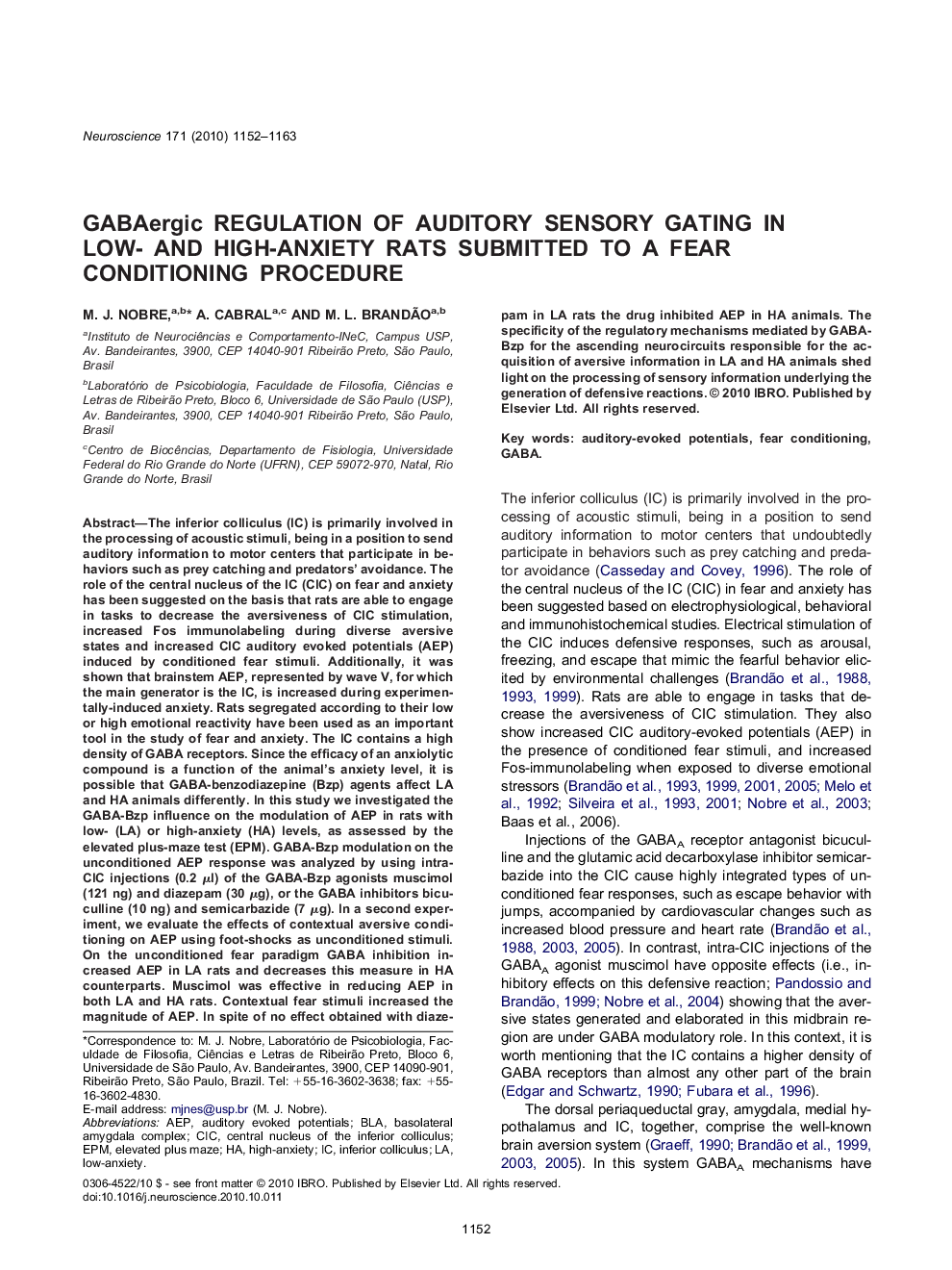| کد مقاله | کد نشریه | سال انتشار | مقاله انگلیسی | نسخه تمام متن |
|---|---|---|---|---|
| 4339190 | 1295738 | 2010 | 12 صفحه PDF | دانلود رایگان |

The inferior colliculus (IC) is primarily involved in the processing of acoustic stimuli, being in a position to send auditory information to motor centers that participate in behaviors such as prey catching and predators' avoidance. The role of the central nucleus of the IC (CIC) on fear and anxiety has been suggested on the basis that rats are able to engage in tasks to decrease the aversiveness of CIC stimulation, increased Fos immunolabeling during diverse aversive states and increased CIC auditory evoked potentials (AEP) induced by conditioned fear stimuli. Additionally, it was shown that brainstem AEP, represented by wave V, for which the main generator is the IC, is increased during experimentally-induced anxiety. Rats segregated according to their low or high emotional reactivity have been used as an important tool in the study of fear and anxiety. The IC contains a high density of GABA receptors. Since the efficacy of an anxiolytic compound is a function of the animal's anxiety level, it is possible that GABA-benzodiazepine (Bzp) agents affect LA and HA animals differently. In this study we investigated the GABA-Bzp influence on the modulation of AEP in rats with low- (LA) or high-anxiety (HA) levels, as assessed by the elevated plus-maze test (EPM). GABA-Bzp modulation on the unconditioned AEP response was analyzed by using intra-CIC injections (0.2 μl) of the GABA-Bzp agonists muscimol (121 ng) and diazepam (30 μg), or the GABA inhibitors bicuculline (10 ng) and semicarbazide (7 μg). In a second experiment, we evaluate the effects of contextual aversive conditioning on AEP using foot-shocks as unconditioned stimuli. On the unconditioned fear paradigm GABA inhibition increased AEP in LA rats and decreases this measure in HA counterparts. Muscimol was effective in reducing AEP in both LA and HA rats. Contextual fear stimuli increased the magnitude of AEP. In spite of no effect obtained with diazepam in LA rats the drug inhibited AEP in HA animals. The specificity of the regulatory mechanisms mediated by GABA-Bzp for the ascending neurocircuits responsible for the acquisition of aversive information in LA and HA animals shed light on the processing of sensory information underlying the generation of defensive reactions.
Research Highlights▶Rats selected as low- (LA) or high-anxiety (HA), as assessed by the elevated plus-maze test (EPM), were subjected to measurements of the auditory evoked potentials (AEP) in the central nucleus of the inferior colliculus (CIC). ▶The AEP magnitudes significantly correlated with the time spent in the open arms by LA and HA rats subjected to the EPM. ▶GABA mediates the processing of incoming aversive information in the IC, playing a regulatory role in sensory gating of aversive auditory information. ▶Fear-eliciting stimuli, such as the context where rats previously received foot-shocks, increased AEP in the CIC of LA and HA rats. ▶Intra-CIC diazepam showed selective effects on fear-potentiated AEP in HA animals.
Journal: Neuroscience - Volume 171, Issue 4, 29 December 2010, Pages 1152–1163